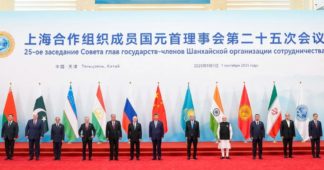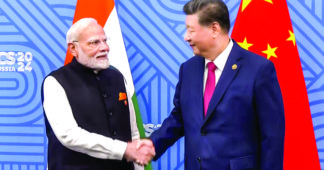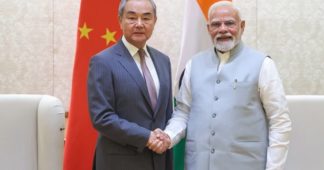By Lasanda Kurukulasuriya*
Oct 18, 2025
In 2023 a Chinese geophysical research ship named ‘Shi Yan 6’ heading for the Port of Colombo, caused a furore, with India and the US loudly protesting its scheduled visit to Sri Lanka. An Indian politician was quoted in Indian media warning that the vessel was on a ‘spying’ mission targeting India’s southern sea. In Sri Lanka a senior political analyst argued that Indian fears were over-hyped, seeing that China did not need to make ship visits to spy on India’s military assets since it had advanced satellites that could do that job.
However another report elsewhere, suggested that the real ‘concern’ of the protesters related to hydrographic data that China might collect in the course of its research, which could be used for military purposes. Possibly informed by diplomatic sources, this report, noting that Sri Lanka “says it advocates a neutral foreign policy” went on to add: “However, India, Japan and the United States are skeptical about Chinese maritime activities in the Sri Lankan territorial waters since they fear that it is part of a major effort by China to systematically map the seabed across the vast swath of the Indian Ocean. They fear hydrographic data, collected in the process, can be used for security related purposes later.” Amidst objections, Shi Yan 6 was permitted to carry out research for a limited period of two days, in defined areas and with scientists from the National Aquatic Resources Research and Development Agency (NARA) and observers from Sri Lanka Navy onboard.
Not long after this episode Sri Lanka announced a moratorium on foreign research vessels entering its waters for a period of 12 months starting Jan. 2024. At the same time it (reportedly) formulated Standard Operating Procedure (SOP) for such visits. But there appears to have been a lack of clarity in this messaging, which may have been responsible for the muddled situation that developed when a German research vessel was allowed to make a port call during the moratorium, leading to protests from the Chinese embassy in Colombo. A second Chinese research ship visit had been preempted on account of the moratorium.
Sovereignty issues
As these events show, in recent years it appears that Hydrography has become a flashpoint in the ongoing geopolitical contest between big powers in the Indian Ocean. “Hydrography, the mapping of bodies of water and surrounding coastal details, is the new front in the battle for influence in the Indian Ocean” wrote David Brewster of the National Security College at the Australian National University. “There is growing competition among India, China and others to chart international waters as well as the exclusive economic zones of countries around the region.” He observed that “Hydrography is now assuming a geopolitical focus with major powers competing to provide hydrographic services to countries with few capabilities or little expertise in this area. This is used to demonstrate regional leadership and, more importantly, gain access to data vital for military purposes such as submarine operations.” Brewster refers to the controversies that arose over Chinese research vessels visiting Sri Lanka (October 2023) and the Maldives (February 2024), as examples of smaller nations that need to build their own sovereign capabilities in relation to their maritime domain. He suggests that Australia can play a useful role in this regard. (Mapping the oceans is the new front in the battle for influence in the Indian Ocean – The Lowy Interpreter 27.03.24)
In months that followed Australia gifted hydrographic equipment and maritime surveillance aircraft to both Sri Lanka and the Maldives. Australia has cordial bilateral relations with Sri Lanka, against a backdrop where Sri Lanka has helped it to curb people smuggling and illegal immigration. However Australia makes no secret of the strategic dimension of its relations with Sri Lanka (as with the Maldives). In June, visiting Australian Deputy PM and Minister of Defence Richard Marles, addressing a selected group of journalists in Colombo said that “We see this region as profoundly strategically important for us” and that “China does represent an ongoing security anxiety for us. and we’ve seen a very significant military build up on the part of China..” Australia, along with India, Japan and the US, is a member of the Quad (quadrilateral strategic alliance), a grouping with shared concerns over China’s growing strategic footprint.
During President Anura Kumara Dissanayake’s state visit to India in Dec. 2024, Prime Minister Narendra Modi during the joint press briefing declared “We have decided to quickly finalise the Security Cooperation Agreement. We have also agreed to cooperate on Hydrography.” The joint statement issued on the occasion also said, under the heading ‘Strategic and Defence Cooperation,’ that both leaders agreed to “Foster cooperation in hydrography.”
Seabed 2030 – a game changer?
Against a backdrop of fraught relationships in the race among big powers and their allies to gain advantage in the strategically important Indian Ocean region, recent advances in hydrographic studies under an ongoing global project would seem to be a potential game-changer. ‘Seabed 2030,’ according to its website, “aims to bring together all available bathymetric data to produce the definitive map of the world ocean floor by 2030 and MAKE IT AVAILABLE TO ALL” (emphasis added).
‘Seabed 2030’ was the subject of an informative and absorbing presentation at the Lakshman Kadirgamar Institute on 07th Oct. under its ongoing series on maritime affairs titled ‘Admiral’s Morning.’ Responding to questions, the series’ presenter Rear Admiral Y N Jayarathna (Retd), Chief Hydrographer of the Sri Lanka Navy and its Chief of Staff, offered insights on a range issues. Asked if there was ‘strategic risk’ in the Sri Lanka National Hydrographic Office having commenced production and sale of Electronic Navigation Charts (for a annual fee of USD 25 per user), he explained that it is a ‘commercial business’ where the market is dominated by the UK and India. Sri Lanka gets a royalty fee. “When there is foreign investment they claim the rights over it. Then we lose our rights. This is the strategic issue.” Regarding ongoing joint hydrographic surveys with India, he said that India had sought ‘chart producing status (replacing UK Hydrographic Office) but that was not given as it could be used for military purposes.
Currently the production of nautical charts by SLNHO is done in collaboration with the UK Hydrographic Office. UKHO’s ‘Admiralty Chart Folio 42 – Sri Lanka & Approaches’ contains 25 nautical maps, of which 16 are of Sri Lanka’s coastal areas and surrounding waters. They include harbour locations of Colombo, Trincomalee, Hambantota and Galle. The maps are available ‘on demand’ for a price of UK pounds 42.99 each.
In February this year the UKHO signed an Agreement with SLNHO, that Sri Lanka Navy described as ‘historic’ as it would boost its hydrographic capabilities. “The partnership will focus on knowledge sharing, capacity development, technical cooperation, and generating revenue by marketing Sri Lanka’s hydrographic products globally,” the SLN report said.
Sri Lanka could no doubt benefit from of shared knowledge, technology and equipment from states more advanced in this field. But unless government is able to navigate the complexities created by competing external interests, with a keen awareness of maritime affairs built into its policy decisions, it could come to grief, with Sri Lanka ending up the site of a proxy war.
“We lose credibility globally owing to the lack of maritime governance,” Jayarathna says. “We are never seen as a maritime state … The 21st century, it’s all about the ocean.”
In June 2025 ‘Seabed 2030’ announced that 27.3% of the world’s ocean floor has now been mapped. When the project was launched in 2017, as a collaboration between GEBCO (General Bathymetric Chart of the Oceans) and the Nippon Foundation, only six per cent of the oceans had been mapped to modern standards, a GEBCO press release said.
A hypothetical question that comes to mind is, if mapping data for the entire ocean bed is made available to all in an ‘open source’ way, and competition is replaced by collaboration as a result of Seabed 2030, could this put an end to the dog-fight to gain access to it? In other words could it level the playing field?
We remind our readers that publication of articles on our site does not mean that we agree with what is written. Our policy is to publish anything which we consider of interest, so as to assist our readers in forming their opinions. Sometimes we even publish articles with which we totally disagree, since we believe it is important for our readers to be informed on as wide a spectrum of views as possible.











